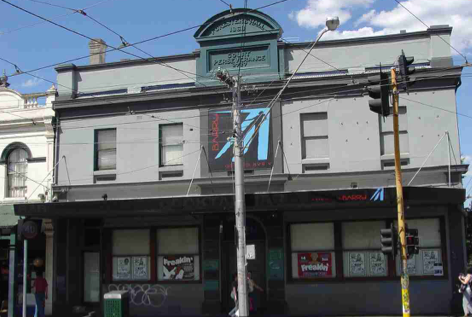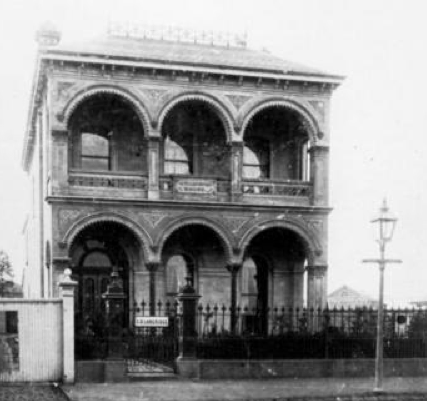Collingwood Notables Database
George David Langridge
1829-1891
Carpenter, contractor, estate agent, councillor, mayor, Member of Parliament, Protectionist
Langridge will be a name familiar to Collingwood residents, if for no other reason than the existence of the street named after him. Many others will have admired his mansion in North Terrace, Clifton Hill, probably without knowing for whom it was built. They may also have noticed the large building at 64 Smith Street known as Foresters Hall and wondered what the words on the pediment – Court Perseverance - signify. To nineteenth century Collingwoodians, on the other hand, he would have been a household name in his role as councillor, politician, auctioneer, proprietor of the Langridge Mutual Permanent Building Society, and Freemason, not to mention his involvement with local cricketing and football teams. And as he entered the Victorian Government Ministry, eventually acting briefly as Premier, he was known far more widely.
Langridge completed a carpentry apprenticeship in England and went into the building businees with his brother before being tempted by the Australian gold rush. He tried NSW, Ballarat and Bendigo in 1853 without much success before moving to Collingwood and resuming his trade, soon setting up in his own business. He bought land in R Henry Way’s recently subdivided Islington Estate and built a house, which, though in modest Harmsworth Street, was built of brick, had six rooms and had the highest rates valuation of all houses in the street.
In the meantime he had become interested in politics. In the face-to-face culture of mid-nineteenth century Collingwood, getting ahead had a lot to do with your local networks. Just near Langridge’s Harmsworth Street house stood the Willow Tree Hotel, which under landlord Richard Norton became a centre for discussion of municipal affairs. The Loyal Hand of Friendship, an Oddfellows Lodge, had been established in 1858 and met at the Willow Tree, and Council election meetings were held there. Langridge was elected a lodge official, as was Charles Swift who also lived in Harmsworth Street. With these excellent connections, both men were elected to council in 1865. Langridge was mayor in 1867 and 1872. During his time on council, underground drainage of the swampy Collingwood flat was begun, using a Government grant and a loan.
Langridge was an enthusuastic proponent of Friendly Societies, which provided members with sick pay, medicine and funeral costs. In 1865 he delivered a lecture on the Manchester Unity Independent Order of Oddfellows, later published as a pamphlet, at the Fitzroy courthouse. Langridge was not only a Grand Master of the M.U.I.O.O, but also a member of the Freemasons Earl of Carnarvon Lodge, and of the United Ancient Order of Druids.
In 1869 he opened an auctioneering and estate agency in a rented office on the corner of Smith Street and Langridge Street forming part of the Foresters Hall building, home to the Ancient Order of Foresters Friendly Society. His building background, involvement in real estate, and philosophical ideals regarding friendly societies led him to endorse the role of building societies in enabling the working man to purchase his own home. In 1869 he founded the East Collingwood Building Society. By 1873 he had added the Collingwood and Fitzroy Building and Investment Society and following its termination established the Langridge Mutual Permanent Building Society in 1880. This was still operating in the 1970s.
His last year on council was in 1873, and the following year he was elected MLA for Collingwood, holding the seat for 17 years. He was variously Commissioner for Public Works, vice-president of the Board of Land and Works, and Member of the Melbourne Water Board, Commissioner of Public Works, Comissioner of Trade and Customs, Chief Secretary, and Minister for Health. During this last ministry the Metropolitan Board of Works was finally created. He was described as ‘of genial character and unaffected bearing’ and a speaker ‘to whom the House took kindly because he did not speak out of reason, and was never verbose’. ‘Cheery, honest, genial’ was the verdict from the Footscray Independent, along with admiration for his support for the Eight Hour Day.
In the 1860s Langridge had begun buying land in North Collingwood, a sparsely-settled area later called Clifton Hill. As well as a substantial block in Heidelberg Road (now Queens Parade), on which he erected a seven room stone house, he owned land in Turnbull Street. He lived in Heidelberg Road for only a few years and by 1874 was living behind his workplace in Smith Street. By 1883 construction of his new home in North Terrace Clifton Hill had begun. It seems probable that George Langridge himself took charge of the construction though it was designed by others, and that he used the services of contractor William Wells as clerk of works The costs dated from April 28 1883 to October 2 1884 are listed meticulously in Langridge’s copperplate script in a leather-bound volume secured with a brass clasp; costs for labour and materials include bricks, plaster, timber, ironmongery, stairs, asphalting, mantles, glass, oven, gas fittings, plumber, ornamentals, hall lamp, ironwork, fencing and garden. Langridge’s land of over an acre ran through to Turnbull Street which provided access to the stables and where a timber dwelling housed his groom.
This mansion, Wellington House, was a clear symbol of success in business, trade and politics. It was later lived in by prosperous butcher John Woolcock, and later Edgar Wilkins, butcher and mayor, during whose residence its name was changed to Kamarooka. It was bought by the Catholic Church in 1924 as a residence for the Sisters of Charity, who taught at nearby St John’s School from 1894 to 1990. The house was sold to private owners in 2010.
Langridge died of apoplexy while holding the office of Chief Secretary and acting Premier. Despite some ill health a few years previously, his death was quite unexpected and regarded as a great loss to the State of Victoria. His son George Thomas had joined his firm and after his death G D Langridge and Son, estate agents, continued in business at 64 Smith Street, as well as their city office, and a branch in Queens Parade Clifton Hill. In 1934 the Collingwood office moved to 62 Smith Street, on the south corner of Langridge Street, where the business remained until 1973.
Foresters Hall
12 North Terrace
Life Summary
| Birth Date | Birth Place |
|---|---|
| 1829 | Tunbridge Wells, Kent, England |
| Spouse Name | Date of Marriage | Children |
|---|---|---|
| Maria Elizabeth Meade, c. 1830-1874 | 1851 | Nine sons and two daughters Four sons and a daughter survived him |
| Emily Judson nee Holt | 1877 | None |
| Home Street | Home City | Status of Building |
|---|---|---|
| Harmsworth Street | Collingwood | Demolished |
| Queens Parade, east of Wellington Street | Clifton Hill | Demolished |
| 64 Smith Street | Collingwood | Extant |
| 12 North Terrace | Clifton Hill | Extant |
| Work Street | Work City | Status of Building |
|---|---|---|
| 64 Smith Street | Collingwood | Extant |
| Church | Lodge |
|---|---|
| St Philip's Anglican, Abbotsford | MUIOOF |
| Earl of Carnarvon | |
| United Ancient Order of Druids |
| Death Date | Death Place | Cemetery |
|---|---|---|
| 24 March 1891 | Clifton Hill | MGC |
Barrett, The inner suburbs; Davison, The rise and fall of Marvellous Melbourne; Hibbins, A short history of Collingwood; information from family descendant; research by G Loughlin and C Goodman; La Nauze, Engineer to Marvellous Melbourne: the life and times of William Thwaites; The Observer; The Argus; The Australasian; The Mercury; Independent



